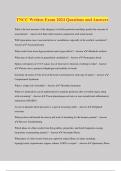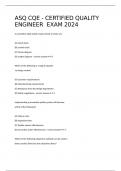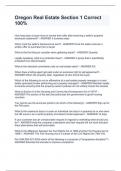TNCC Written Ex am 2024 Questions and Answers What is the best measure of the adequacy of cellular perfusion and helps p redict the outcome of resuscitation? - Answer ✔️✔️-Base deficit used in conjunction with serum lactate Will hypocapnia cause vasoconstriction or vasodilation, especially in the cerebral vasculature? - Answer ✔️✔️-Vasoconstriction What results from tissue h ypo perfusion and oxygen deficit? - Answer ✔️✔️-Metabolic acidosis What type of shock results in generalized vasodilation? - Answer ✔️✔️-Neurogenic shock Spinal cord injuries at C3 -C5 causes loss of what nerves function, resulting in what? - Answer ✔️✔️-Phrenic nerve; paralyzed diaphragm and inability to breath Extremity elevation AT the level of the heart is beneficial for what type of injury? - Answer ✔️✔️-
Compartment Syndrome What is a high risk of frostbite? - Answer ✔️✔️-Thrombus formation What two med ications can be administered to maintain perfusion after a frostbite injury along with rewarming? - Answer ✔️✔️-Tissue plasminogen activator or non steroidal anti -inflammatory medication (NSAIDS) An rise in diastolic blood pressures is a sign of increasing what? - Answer ✔️✔️-Peripheral resistance What position will benefit the airway and work of breathing for the bariatric patient? - Answer ✔️✔️-Reverse Trendelenburg Which phase of a blast results from flying debris, projectiles, and bomb fragments causing lacerations or penetrating injuries? - Answer ✔️✔️-Secondary Phase What phase of a blast results from any explosion -related illness or injury including hyperglycemia, hypertension, angina, asthma, COPD, or sepsis? - Answer ✔️✔️-Quaternary Phase What phase of a blast results from individuals being thrown by the blast and impacting walls, ground, or any hard object? - Answer ✔️✔️-Tertiary Phase What phase of a blast results from impact of the over and under pressurization wave with body surfaces. Injuries in clude blast lung, tympanic membrane rupture, abdominal hemorrhage, globe rupture, and mild traumatic brain injury? - Answer ✔️✔️-Primary Phase Signs of what include muscle pain or weakness, dark red or brown urine, general weakness or malaise, and elevated creatinine kinase levels? - Answer ✔️✔️-Rhabdomyolosis Signs of what include anxiety, pleuritic chest pain, dyspnea, hypoxemia, hemoptysis, cough, orthopnea, adventitious lung sounds, decreased lung sounds, jugular vein distention, or hypotension? - Answe r ✔️✔️-Pulmonary Embolus Signs of what include headache, nausea and vomiting, amnesia, behavioral changes, altered level of consciousness? - Answer ✔️✔️-Increased intracranial pressure Signs of what include asymmetric pupillary reactivity, unilateral dilat ion, widening pulse pressure, abnormal motor posturing, bradycardia, and decreased respiratory effort? - Answer ✔️✔️-Late signs of increased ICP with Herniation Syndrome What is caused by the tear of the bridging veins or middle meningeal artery? - Answer ✔️✔️-
Subdural and Epidural Hematoma Affect concentration, memory, sleep, mode, and libido. Causes headaches, dizziness and nausea. - Answer ✔️✔️-Postconcussive Syndrome/ Mild Traumatic Brain Injury Signs and symptoms similar to early signs of increased ICP but do not worsen. - Answer ✔️✔️-
Postconcussive Syndrome/ Mild Traumatic Brain Injury Cerebral Perfusion Pressure = ______ -______ - Answer ✔️✔️-MAP - ICP What is the ran ge for CO2 to maximize perfusion? - Answer ✔️✔️-35-45 Does hypoventilation cause dilation or constriction? Increase or decrease ICP? - Answer ✔️✔️-
Dilation and increase in ICP due to high CO2






